Myoelectric Arm
The Myoelectric Arm Project
A project at Vigyan Ashram, Pune aims to set up capabilities in India such that myoelectric hands in the price band of ₹10,000 to ₹30,000 are available for fitting to those in need. At a later stage the project would work with other institutions such that a few engineering colleges have centers for Prosthetics and Exoskeletons for further innovation. The world is in a ferment in these two areas. A lot of development is taking place with implications for public health and military and with many Indian scientists working abroad in these areas.
The innovation involved
- 3D printing with Acrylonitrile butadiene styrene (ABS) / Polylactic acid (PLA) and flexible filaments
- Myoelectric sensors
- Stepper motors, Servo motors and DC motors with continuously variable transmission (CVTs) to power the myoelectric arms
- Value Engineering to reduce the cost from ₹3,75,000 to ₹10,000 per item
Why Vigyan Ashram
Vigyan Ashram has been a pioneer in installing and using fab labs. 3D printers are essential parts of a modern fab lab.
I have been associated with Vigyan Ashram as a volunteer. Having some expertise in 3D printing, I brought to Vigyan Ashram's notice a few articles in the New York Times about using 3D printers to print prosthetic hands that were suitable for near the wrist injury.
- 3-D Printing Prosthetic Hands That Are Anything but Ordinary - Feb 16, 2015
- 3-D Printing Is Spurring a Manufacturing Revolution - Sep 13, 2010
Vigyan Ashram and I together surveyed the field and determined that nobody was offering any solutions in this manner in India. However, the role of Jaipur Foot in catering to lower limb injuries is well known internationally. It was decided that a preliminarily talk with them would clarify the need for action. I approached the Jaipur Foot organisation with a 3D hand model printed charitably by an medical device organization at Delhi and assembled with Vigyan Asharm's help.
The doctors at Jaipur Foot studied the prosthetic hand but judged that we were trying to solve the wrong problem i.e. near the wrist injury. In their opinion the real need of the country was a solution to near the shoulder injury for which the myoelectric hand at ₹3,75,000 was not a practical solution for the masses of the country. They challenged us to develop a myoelectric arm at a price point of ₹10,000 so that they could give away the solution in charity. This challenge was the genesis of the Myoelectric Arm project in May 2015.
Plan for undertaking the project
Through its fab lab programme, Vigyan Asharm was already in contact with Nicolas Huchet, who had made a prosthesis for himself with 3D printed parts and open source hardware. Most details of the first version of the hand that he had developed were available on his personal blog.
College of Engineering Pune (CoEP) has a Robot Study Circle and excellent 3D printing facilities in its Robotics and Automation Lab. Vigyan Asharm works with CoEP on many projects. CoEP was ready to help Vigyan Asharm with specific problems. They could make available certain facilities negotiated on highly concessional terms.
I had undertaken drastic cost reduction exercises in past and was confident that a price band of ₹30,000 to ₹10,000 was achievable. Even if we failed and could reach only ₹50,000 as a price point, it would make a huge difference to the country.
The plan was that a small group of volunteers would be formed who would study two types of hands:
- The Bionico hand of Nicolas Huchet's design. This was a myoelectric hand where we could ask questions and get quick direct answers.
- The Raptor Hand from enablingthefuture.org as that would enable us to absorb the 3D printer technology at very little cost.
Progress so far
A software giant company at Pune decided to chip in with volunteers to work with us. The progress that has been made so far and which will be continued to make does not depend on the people behind the project; rather all doors have opened and all resources made available to us when people understand the social impact of the project. The goodwill of the people is pushing the project ahead. In the six months that the project has been running, the progress has been far more than expected.
- We have been able to understand, assemble and make a myoelectric hand that articulates all the five fingers.
- In a playful manner, we have made another battery powered, computer controlled hand that is voice controlled. At the moment that has no practical application but there is a monopoly in making of muscle sensors and the voice control offers a long term solution to go around the monopoly.
- If we cost what we are making only on the basis of cost of items used and do not account for any overheads, finance costs, depreciation etc then the present costs are about ₹30,000 per hand.
Plan for the next three months
Based on a review of the progress made so far, we have come to realise that so far we have taken a hobby-like approach to making the hand. That is, the intention had been to make a working prototype.
- In the next three months we plan to switch to a production oriented, better tested for field use pyroelectric hands.
- There are a number of open source myoelectric hands that need to be evaluated and from the models for which most details are available, we need to choose two of them for making the next three field use hands.
- These field use hands will be tailored made and fitted to actual patients.
- We will work with Jaipur Foot for this purpose as well as getting feedback on how the hands fare in the field.
One year plan
- By November 2016 we intend to further produce and fit about 20 to 25 myoelectric hands. All these hands will be produced by 3D printing technologies. However we will try to make the hand do more tasks by looking at various ways to make the fingers. Palms, internal connections and use of electric motors and different types of muscle sensors.
- We intend to pursue Value Engineering technologies. Annex C has some details of the strategies for Value Engineering.
- We intend to set up a testing lab for checking out the usefulness of various designs.
- We need to prepare rehabilitation videos and picture booklets for the patients.
Caution: Its humbling to realize that even after all this is achieved there will be many people with defects in upper limb whom we will not be able to help with what we are trying to develop.
Myoelectric Hand Components
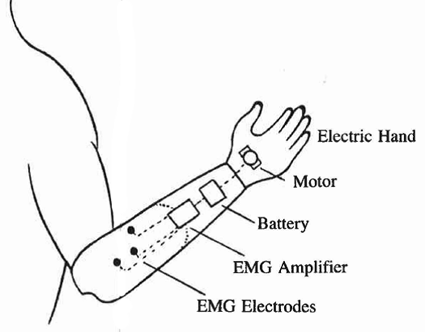 Myoelectric Hand Components (Diagram courtesy IEEE)
Myoelectric Hand Components (Diagram courtesy IEEE)
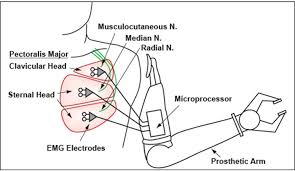 Myoelectric Hand Components (Diagram courtesy U.S. Department of Veterans Affairs)
Myoelectric Hand Components (Diagram courtesy U.S. Department of Veterans Affairs)
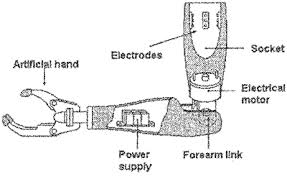 Myoelectric Hand Components (Diagram courtesy U.S. Department of Veterans Affairs)
Myoelectric Hand Components (Diagram courtesy U.S. Department of Veterans Affairs)
| Description | Materials | Remarks |
|---|---|---|
| Outer Shell | Thermo setting FDA approved plastics such as ABS / PLA / Nylon / Polypropylene / HDPE, etc | About 700 grams per hand. Between $ 30 to $ 40 per Kg when printed using 3D printers. |
| Sensors | Transducers, myoelectric sensors/ Inserted myoelectric sensors. Sensors not on residual stump. | Transducers are old technology. Myoelectric sensors are relatively new. Bionic sensors are beginning to be available. About $50 and more. Electrodes may be a recurring expenses. |
| Processing Unit | Either Ardunio and its variants can be used or Rasberry Pi can be used. Software libraries are available. | Relatively cheap. Maximum $ 25. |
| Motors | Stepper Motors with additional boards to control them. Servo Motors, DC Motors, Continuously Variable Transmissions | Optimal Mix of type and numbers has to be determined. Usually each motor represents one degree of freedom. We are aiming to use between 3 to 5 motors. |
| Miscellaneous | Nylon cords, elastic cords etc | Low cost but to be chosen with care to ensure long usage. |
Value Engineering
Plastics
A typical myoelectric hand has about 700 grams of thermosetting plastic in it. If it has been printed by a 3D printer, then the printing process has used support material that costs less than the material that stays in the final product.
The main two plastics used with 3D printing are ABS and PLA. Both are roughly equivalent and in some matters, such as lower glass temperature PLA is superior.
When they are sold in granule form both cost about $2 per kg.
When the same granules are heated and formed into a wire that is feed into a 3D printing machine, the price shots up to $ 30 to $ 40 per kg.
This is the same phenomenon that is associated with other computer driven printers such as ink jet and laser printers. Consumables like ink cost the earth while the printers are low priced.
One value engineering option would be to make the shell of the myoelectric hand using low volume injection molding process. It is expected that the part would then cost about $5 per kg. This option is being explored.
The second option already explored by two other arm manufacturers is to use plastics like nylon/polypropylene or HDPE.
The University of Massachusetts Lowell, USA has switched to making the shell with injection molded nylon. We are trying to set up a working relationship with them.
A second hand by Soft Bionics uses polypropylene.
We are contacting a large Indian firm in the field to understand the process of low volume injection molding for various plastics.
Motors
Any combination of stepper motors, servo motors and toy DC motors with continuously variable transmission (CVT) can be used to power the myoelectric arm.
As Stepper motors are hugely used in Robotics and often turned to power a device without any thought.
The principal advantages of the Stepper motors are (I) Easy to control electronically (ii) High torque.
Along with associated boards, they are costly and noisy.
The principal disadvantage is that they consume the highest power when they are idle. A human hand is idle about 90 % of the time and the Stepper motors are consuming the highest power all that time.
Servo motors are DC motors with an attachment that allows them to calculate how many rotation they have undertaken. They are sold with gear transmission attached so that a fixed amount of torque can be produced at proper speed. They are about one fourth or one fifth the cost of Stepper motors.
Many myoelectric arms already use them.
Toy DC Motors with CVTs
Toy DC motors are very cheap but they cannot produce the torque that is required. In the automotive industry, and other engineering areas, the recent trend has been to move away from fixed gear trains and replace the gear train with continuously variable transmissions. Most of the new two wheelers and many four wheelers are equipped with CVTs that allow the customer to do away with gear shift and clutch and still enjoy frugal driving.
In prosthetics, Otto Bock has recently announced the use of DC Motor with CVT to be used at the point of highest torque i.e. the elbow.
Muscle Sensors / Transducers
The field of EMG reading muscle sensor manufacturers is a near monopoly that is not likely to be broken in near term as the volume is very low and there are no economics of scale.
Transducers do not give good control.
In the short run we have to live the prices as they are.
In the long run we wish to do away with the muscle sensor and pick up other signals to control the hand.
Survey of the field
- The ratio of Lower Limb defects to Upper limb defects is about 30 is to 1.
- Lower limb defects are being well taken care of in India.
- Jaipur Foot is a world class innovation and doing a yeoman's service.
- Upper limb defects are essentially not being catered for in India.
- Defects ( including amputations/ loss in accidents) can be readily classified under 3 categories:
- Near the Wrist defects
- Near the Elbow defects
- Near the Shoulder defects
- Broadly there is no cure as yet in India for people who are congenitally born with missing fingers/ palms/wrists. But this is hardly 1% of people with Upper limb defects.
- For people with defects near the elbow (either just below the elbow or just above the elbow) the Artificial Limb factory at Kanpur makes a mechanical arm that ends in a hook. A belt from the shoulders provides the motive power and some limited movements are possible. But this is at par with the treatment offered by England's National Health Service (NHS).
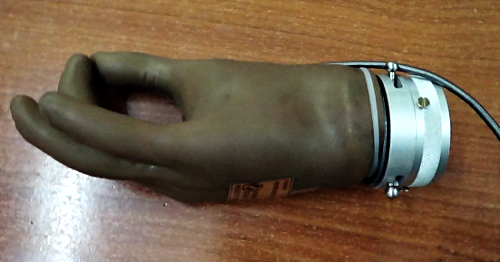 Mechanical arm made by the Artificial Limb factory at Kanpur
Mechanical arm made by the Artificial Limb factory at Kanpur
- Nowadays an American charity, The Ellen Meadows Prosthetic Hand Foundation is providing a free 3d printed hand (LN-4) for such patients. That solution is a great improvement over what is being manufactured in India.
- Near the Shoulder arm injuries are usually the result of an accident. Most cases in India are the result of thresher accidents in India. Even though the thresher has been redesigned and fresh accidents are minimal, it is estimated that there are about 5,00,000 victims who have become a burden on the society for lack of a solution that they can afford. Across the world such accident victims are served by myoelectric hands where the power to move the hand and control its movements is from battery powered motors and control signals are picked up from the skin on the residual limb. Such myoelectric hands are not being made in India and are imported from abroad. Otto Bock is a century old German firm which is the leading source of such myoelectric arms and is also a leading supplier to the Indian Army of such arms. About a year back its myoelectric arm was being priced at about ₹3,50,000. Now, it is importing the components of some of the arms and assembling them in Pune. To special category of customers such arms are being made available at ₹1,75,000 lakhs. OttoBock has recently signed an Memorandum of Understanding (MOU) with Artificial Limbs Manufacturing Corporation of India (ALIMCO), Kanpur for joint development of limbs.
Defects that the Myoelectric Arm can correct
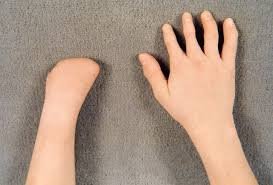 Near The Wrist Defects
Near The Wrist Defects
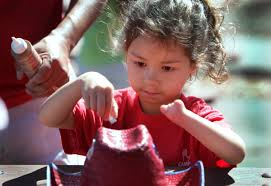 Near The Wrist Defects
Near The Wrist Defects
 Near The Elbow Defects
Near The Elbow Defects
 Near The Shoulder Defects
Near The Shoulder Defects
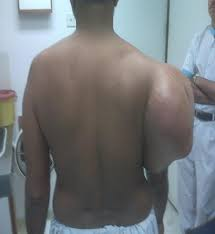 Near The Shoulder Defects
Near The Shoulder Defects